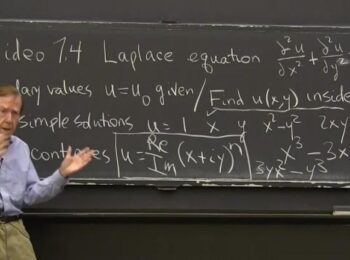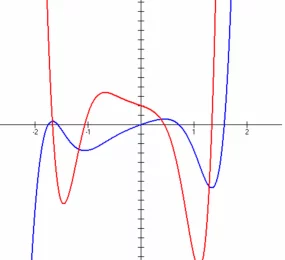Indeterminate forms in calculus begin with algebraic functions that utilize a limit for the independent variable to find a solution. The indeterminate aspect of the form results when different rules vie to apply to the solution.
Since there is no clear way to determine which rule of calculus will govern the answer, the function then becomes an intermediate form. There are many indeterminate forms, but there is only a handful that commonly occurs. For instance, 0/0 and 0 to the power of 0 are examples of more common indeterminate forms.
What is an Indeterminate Form in Calculus?
Replacing algebraic combinations within a function with its limits, assuming an independent variable sometimes results in an answer such as 0/0. In this case, there are several competing rules vying for an opportunity to define this solution.
Indeterminate forms, officially coined by a student of the famed French mathematician Augustin Cauchy, have been around for as long as calculus. However, they have only been studied in the last 150 years or so.
Substituting a limit that results in a zero, infinity, negative infinity, or any combination of these may result in an indeterminate form. When both functions approach the given limit that results in the indeterminate form, there is not enough information to determine what the behavior of the function is at that point.
Some indeterminate forms can be solved by factoring through elimination or using L’Hopital’s rule. The functions resulting in 0/0 and infinity over negative infinity can achieve a solution through various means.
An indeterminate form is a limit that is still easy to solve. It only means that in its current form as a limit put into a function, it presents too many unknowable characteristics to form an appropriate answer properly. You can’t just solve for the quotient.
When solving for a limit, we are looking at two functions so that they make a ratio. Ratios are the most common, but not the only, way to discern an indeterminate function. Several geometric functions are also indeterminate forms, but not ratios.
Finally, while limits resulting in zero, infinity, or negative infinity are often indeterminate forms, this is not always true. Infinity, negative or positive, over zero will always result in divergence. As well, one over zero has infinite solutions and is therefore not indeterminate. We can determine a universal solution, but an indeterminate answer is one that needs more information.
Why are Indeterminate Forms in Calculus Important?
Indeterminate forms hover over the calculus no matter where you turn. When dealing with ratios such as 1/0, 0/0, or infinity in any form, you will most likely need to use a further theorem, such as L’Hopital’s, to solve for a limit. Knowing that indeterminate forms are sometimes solvable can elicit clarity in a function that previously was not available.
Delving further into the particulars of indeterminate forms allows us to utilize a variety of methods to determine the characteristics of a function at a particular limit. Not enough information determines an indeterminate form. However, sometimes, we have too much information and need to whittle down a solution to one technique.
Take the fraction 0/0. An elementary view of this fraction would tell someone that it equals one because a numerator that equals a denominator equals one. Or more practically, we could think of the fraction as just zero. Further, a zero in the denominator could indicate infinity or does not exist. Therefore, there are options for classifying this ratio, but no clear winner stands out.
So why are indeterminate forms necessary in practical, real-life situations? The answer is that they aren’t, at least not by themselves. However, their mere existence provides the ground for individuals to find ways to make indeterminate forms solvable.
Many areas of physics and math will use a denominator of zero as a potential starting point in a variety of situations and formulas. Laws involving physics, heat, and quantum mechanics will use indeterminate forms at some point. Understanding these forms allows you to solve them using an appropriate method, whether that is L’Hopital’s method or another.
From an even more practical standpoint, there could be very general problems involving motion, velocity, and time that require the use of indeterminate forms. Questions surrounding the speed and time of a moving object will have to start at zero. Determining an infinite limit of two of these objects would result in an indeterminate form.
Again, it is critical to note the reason for classifying an indeterminate form as “indeterminate.” It is to differentiate it from other ratios that are zero or does not exist. To alleviate confusion, possibly substituting the word “temporary” for indeterminate would clear up some of the misconceptions surrounding the use of these forms.
Understanding these forms as a transient is a better way to think of them. An indeterminate form, therefore, is just a vehicle for further computation that is up to the discretion of the user.
How to Use Indeterminate Forms
In the real-world, an indeterminate form would take the form of algebraic expression with a defined limit. Let’s say the numerator was x-4, and the denominator was 2x-8. With a limit of 8, what is the value of the ratio? The ratio becomes 0/0.
Once again, 0/0 is an indeterminate form. Solving it further requires some factoring. If we cancel out the variable, we get a ratio of ⅔. Using simple algebra, we can get away from the indeterminate form.
When simple algebra is unavailable for use in solving an indeterminate form, then L’Hopital’s rule becomes necessary. A simple search of the internet results in some handy lists of indeterminate forms.
Typically these lists are arrayed into three columns. The first column lists the indeterminate form. The second shows how to use L’Hopital’s rule to get a ratio to either 0/0 or infinity/infinity. Once the ratio becomes either of those, then they are solved either algebraically or using derivatives.
While L’Hopital’s rule is not precisely real-world applicable on its own, it is also a vehicle for further calculation much like indeterminate forms. Without the rule and the existence of indeterminate forms, calculations for meaningful and applicable formulas in other areas would not be possible.
How do we know when an indeterminate form needs the use of L’Hopital’s rule or needs to use algebra?
- First, input the limit into the functions.
- Solve each function.
- If both the numerator and denominator equal zero or infinity, then you’ve probably got an indeterminate form.
- Attempt to factor functions without inputting the limit.
- If factoring results in a determinate form, then you are done. Otherwise, go on to the next step.
- Find the derivative of both the numerator and the denominator.
- Input your limit into the derivative ratio, and you’ve got your answer. You’ve just made use of L’Hopital’s rule.
When using indeterminate forms, be sure you have a proper understanding of what a derivative is and how to use them. The first step in finding the derivative of a polynomial is to bring each exponent down by one. Multiply the initial exponent by the coefficient. Multiplying allows you to find the derivatives and use L’Hopital’s formula.
It is critical to forming a thorough understanding of L’Hopital’s formula if you will be dealing with indeterminate forms. Instances where you could get end up with zero minus infinity, or infinity minus infinity all call for the use of this rule. The use of derivatives allows you to transform this indeterminate form into 0/0 or infinity over infinity. From there, you can solve using algebra.
There are instances where L’Hopital’s rule will not work with an indeterminate form. If you have zero over infinity, finding the derivative of the polynomials will only lead to the wrong answer. Using the inverse of the infinite polynomial will then change the ratio into an L’Hopital-friendly 0/0 ratio.
Instances, where a function equals zero to the zero power, requires the use of natural logarithms. Subtracting to infinities calls for using the laws of trigonometry and making calculations using cos, sin, and tan. Any indefinite forms that you find in the course of your calculus journey have a method for solving.
Conclusion
While an indeterminate form may not change your life, it can provide the means for further understanding of broader calculus concepts and rules. As well, indeterminate forms are primarily made up of infinity, zero, and one, which is the primary values often dealt with in calculus. Understanding their indeterminate forms is crucial.
Many subject areas will use formulas and calculations involving indeterminate forms. A thorough understanding of how to solve them, and the parts that make up their solutions such as derivatives and trigonometric functions, are fundamental.






